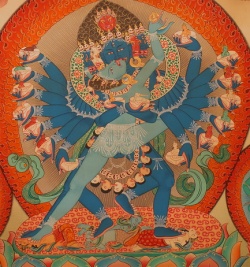Hevajra Tantra
A Buddhist Tantra of twenty chapters, thought to have originated in the eighth century. The name is based on the male deity Hevajra, a personified symbol for the Buddhist concept of a supreme being in the state of nonduality, and as such he is most often depicted or visualized in union (Tib., yab-yum) with the goddess Nairatmya.
The Hevajra Tantra teaches the Union of Skillful Means and Profound Cognition; and states that such union is helpful in achieving the powers known as siddhis. The text belongs to the higher or Inner Tantras and includes the truly famous quote (the one below) that explains a basic tenet of Tantra in only a few words; as do the two others:
"One must rise by that by which one falls"
"By whatever thing the world is bound, by that the bond is unfastened"
"Beings are bound by passion and are released by utilizing passion"
The Tantric reverence towards, and dependance on, women in general (and the yoni in particular), is born out in the following three quotes from the text; as is the clearly intimate nature of most higher and secret rituals:
"At all times, whether washing one’s feet or eating, rinsing the mouth, rubbing the hands, girding the hips with a loincloth, going out, making conversation, walking, standing, in wrath, in laughter; the wise man should always worship and honor the lady."
"Concentrate on the triangle of origination in the midst of space."
"I dwell in the yoni of the female in the form of semen."
The Hevajra Tantra is especially important in the Sakya-pa tradition and served as a blueprint for Virupa's Lamdre text known as Vajragatha.
The text also contains one of the most early lists naming the four major Pithas, sacred places of the goddess
